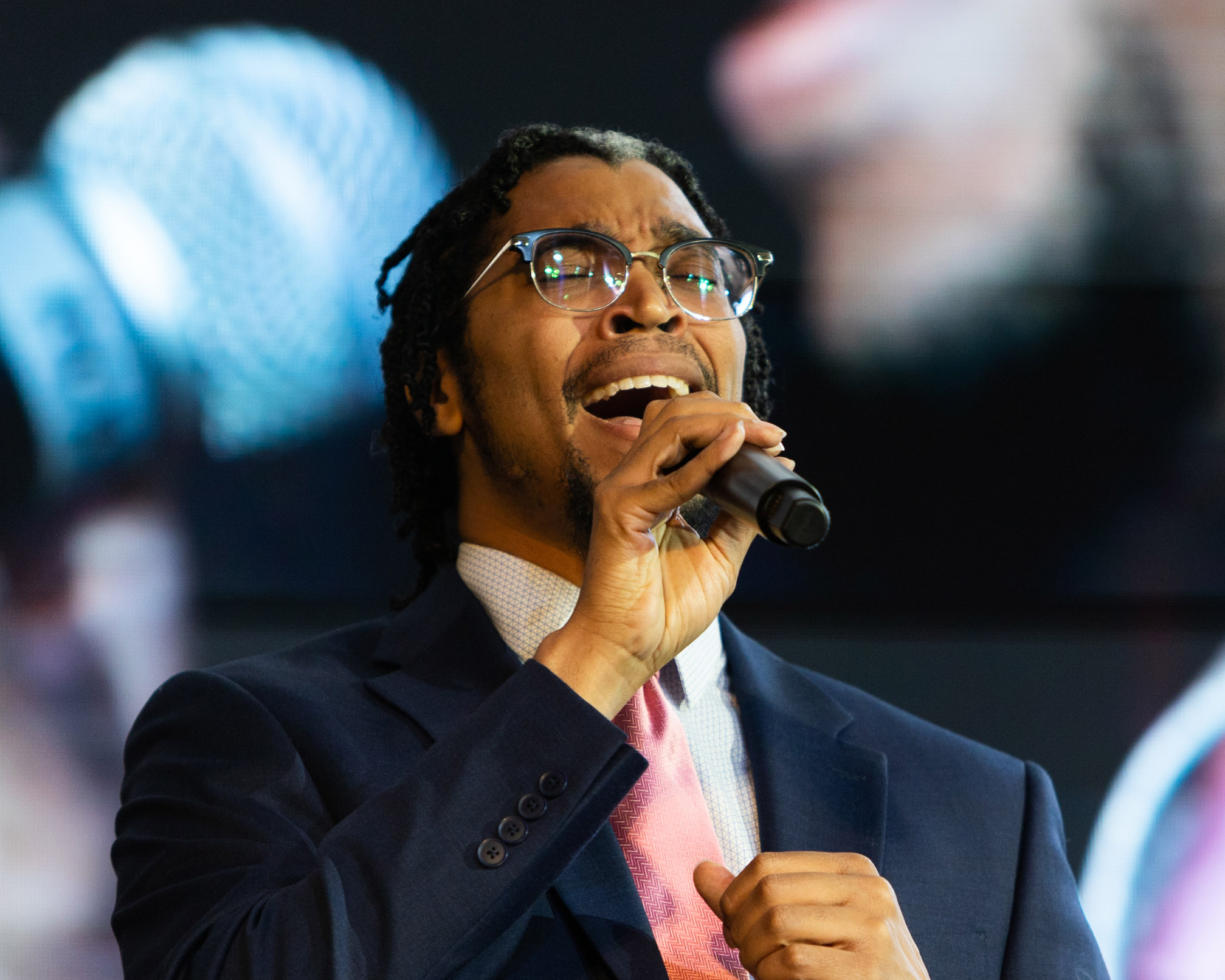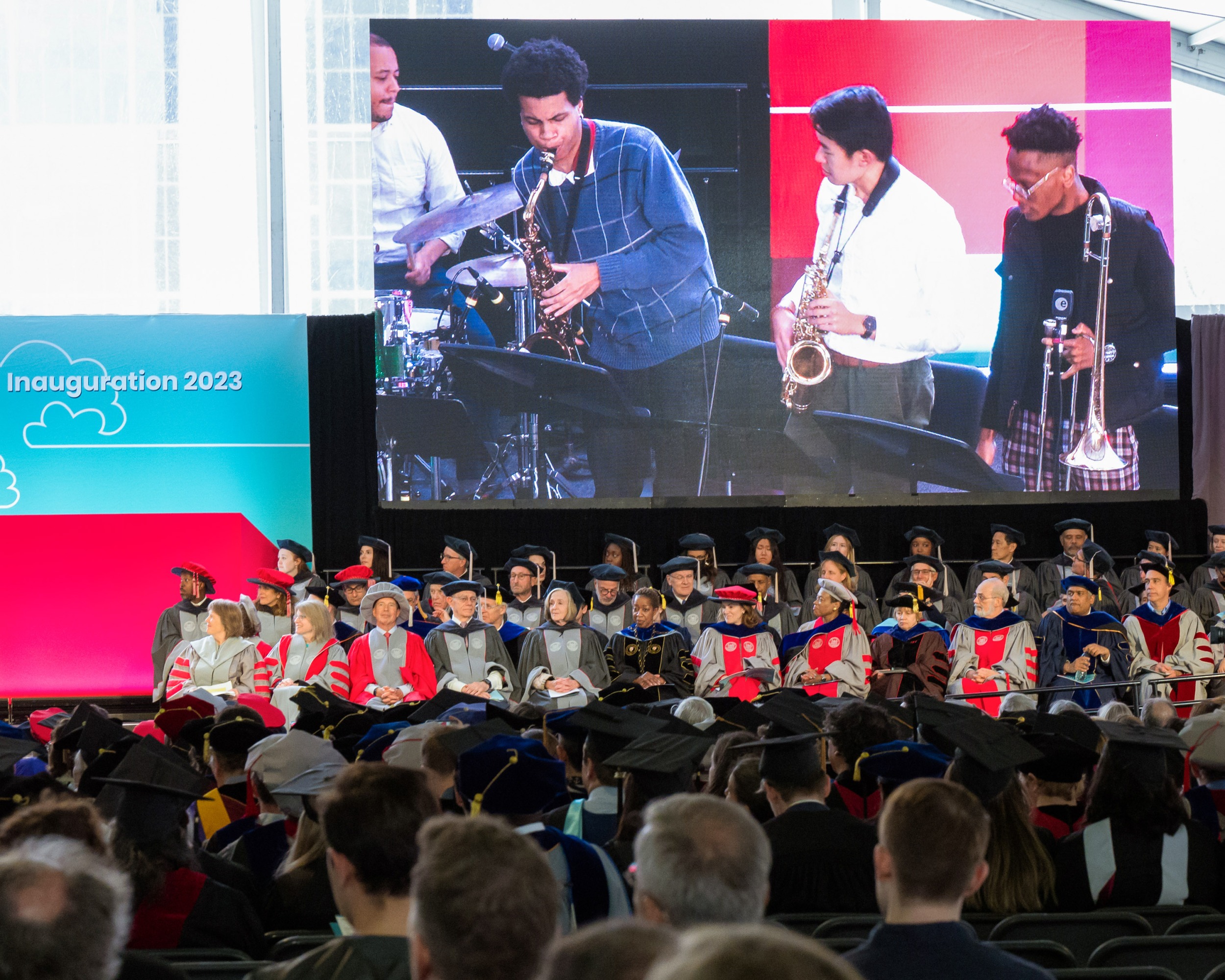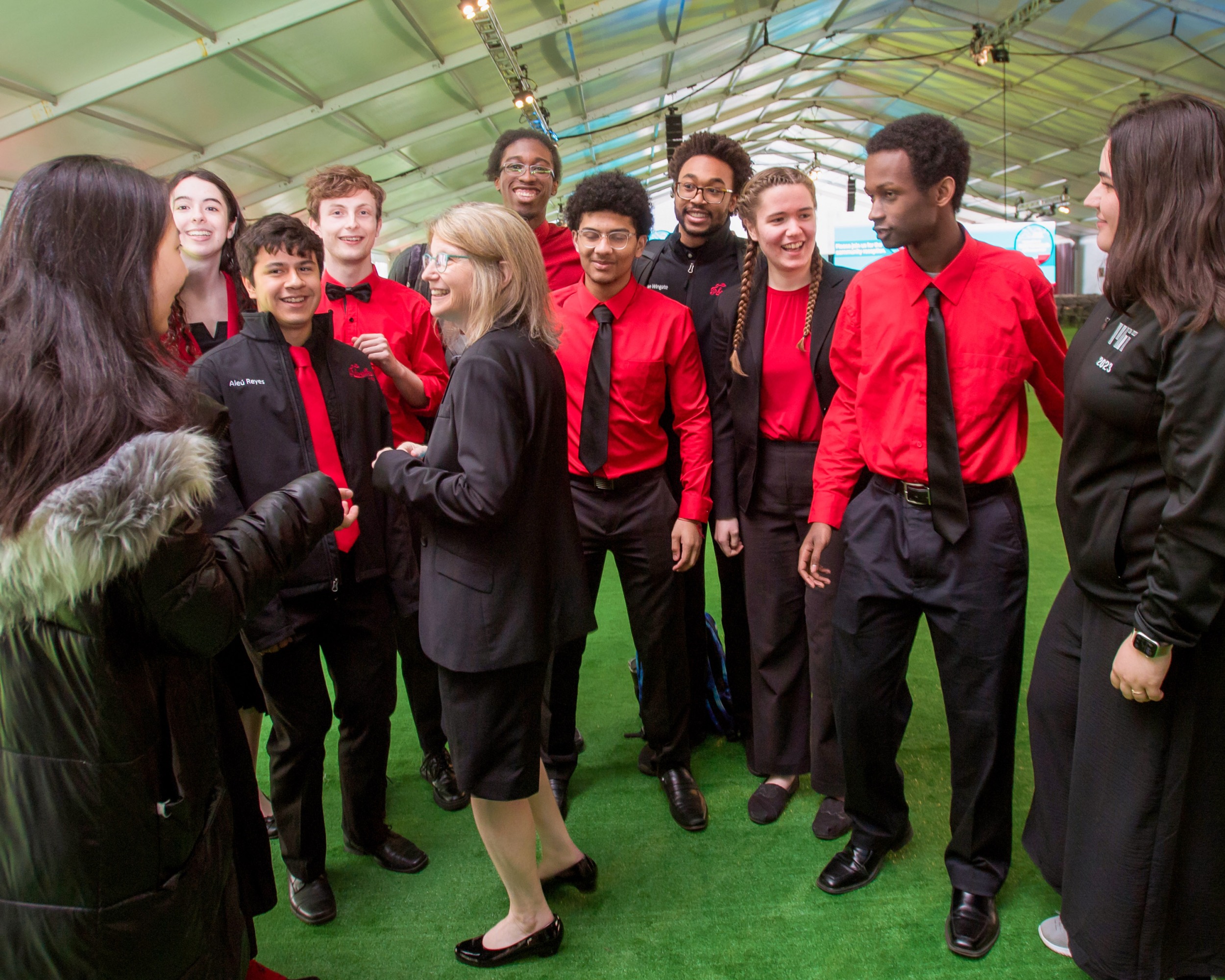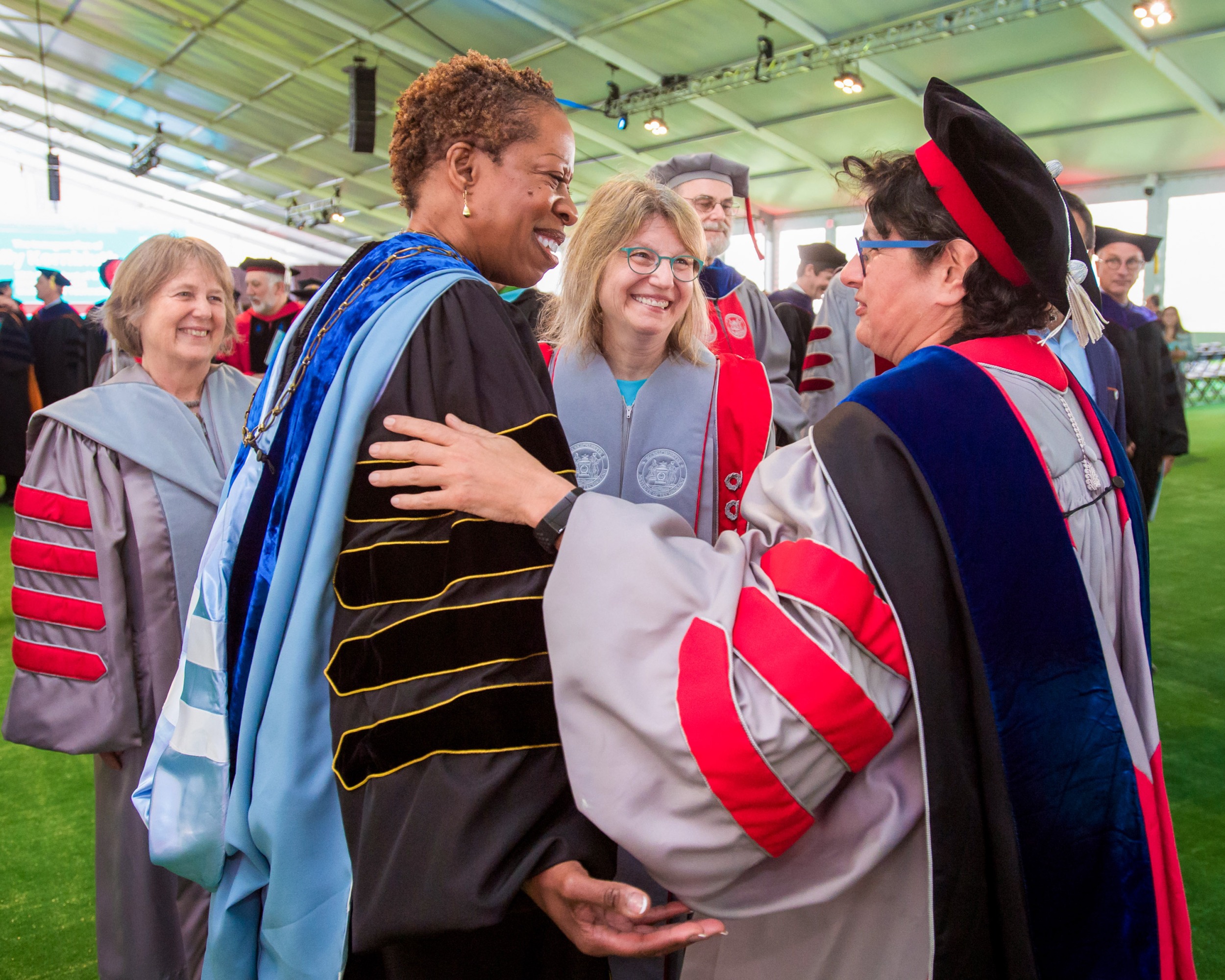Subtotal: 1.655,52€ (incl. VAT)
When MIT met Sally
On May 1, the MIT community gathered in Killian Court beneath what Sally Kornbluth dubbed “the world’s largest umbrella” to officially welcome her as the Institute’s 18th president. But the predicted rain held off, and crabapple blossoms fluttered down from the trees as she was brought into the MIT fold with all the formality and fanfare befitting an academic inauguration.
Kornbluth celebrated what she calls “curiosity unbounded” and made a resounding call in her inaugural address for the entire MIT community to come together to address the “global crises” of the current era. “I hope to inspire you to join us in something important and new,” she said.
Lauding the Institute community’s “signature ability to foster the very best in fundamental research and harness it to confront society’s hardest problems,” Kornbluth noted that many of those challenges will require new research, new forms of collaboration, and renewed efforts to take timely action in society. “As humanity struggles with so many interlocking global crises, it has never needed the people of MIT more than it does now,” she said.
Envisioning MIT in 2033
Valerie Sheares Ashby, president of the University of Maryland at Baltimore County, introduced Kornbluth at the inauguration, praising her values, integrity, and leadership acumen. “She embodies exactly what higher education needs in leadership at this critical moment in the nation and the world: clarity, vision, courage, and humility,” said Sheares Ashby of her former colleague at Duke University, where Kornbluth served as provost. She called Kornbluth “a brilliant scientist, scholar, and teacher,” adding, “This is who she is every day.”
Kornbluth’s inaugural address, delivered after her formal investiture by MIT Corporation chair Diane Greene, SM ’78, and Presidents Emeriti Susan Hockfield and L. Rafael Reif, covered a range of topics, including the role of university leaders and the importance of improving the quality of life for students, developing campus staff, and supporting a diverse faculty. While she noted that it would be “arrogant in the extreme” to offer a detailed strategic vision while still in the midst of her campus-wide listening tour, she outlined an overall vision for MIT 10 years from now. It is reasonable to imagine, she said, that by 2033, Institute faculty and students will have “unraveled daunting intellectual puzzles, from mathematics to materials science, urban planning to economics, neuroscience to nuclear engineering, physics to philosophy to finance,” while also having “helped humanity come to grips with the tectonic forces of artificial intelligence, containing its risks and harnessing its power for good.”
“To meet the challenge of climate, it’s time for the people of MIT to engage in Rad Lab– level thinking and commitment again. I am absolutely certain that this urgent project is the singular effort that needs our shared attention. We can only meet this crisis if we’re brave enough to lower our shields, reach out, and work together in new ways.”
On top of that, she added, she envisions MIT having introduced a new core curriculum and experienced a “new flowering of the humanities and the arts,” which she called “the fields that tell us what it means, and why it matters, that we are human beings—fields that must be equal partners in inventing a just, humane, and equitable future.”
Kornbluth said she anticipates that by 2033 we will have witnessed new links between engineering and biology that will point to “the future of healing” and make Greater Boston “the hub of the next biotech revolution.” She spoke of MIT people using the power of entrepreneurship to “propel profound solutions out to communities around the world, from preventing pandemics to cleaning up plastic waste.” And she envisioned the Met Warehouse, future home of the School of Architecture and Planning and the Morningside Academy for Design, as “a bustling hub of making and design.”
But to genuinely be a success in 2033, said Kornbluth, MIT must make sure it “has truly become a place of inclusive excellence and enthusiastic diversity, where everyone feels that they matter, and they belong.”
Tackling the climate crisis
While Kornbluth cited many MIT endeavors, the subject she discussed at greatest length was climate change, which she called “the greatest scientific and societal challenge of this or any age.” On her campus listening tour, she said, members of the MIT community had “above all, and most urgently” expressed the need for the Institute to continue to “marshal a bold, tenacious response to the runaway crisis of climate change,” a line that received a healthy round of applause.
As she noted, MIT has played a key role in many landmark advances in science and technology previously, including the LIGO program that detected gravitational waves, the Human Genome Project, the Apollo program that put humans on the moon, and the Rad Lab, which helped develop radar during World War II.



President Kornbluth delivered her inaugural address after Ricky Richardson ’12 (middle) and friends performed his composition “Chase Fire.”
“To meet the challenge of climate, it’s time for the people of MIT to engage in Rad Lab–level thinking and commitment again,” Kornbluth said. “I want you, and I need you, to help me imagine what that should look like, and how it can succeed—the kind of grand creative enterprise in which the energy you release together is greater than what you each put in: a nuclear fusion of problem-solving and possibility.”
Kornbluth said she “would not presume” to outline all the forthcoming facets of MIT’s climate efforts but added, “This is work we will do together, starting now. We need energy and expertise from every MIT school and the college [of computing], from every lab and every center, from every member of the faculty—and from every one of you.”
“Curiosity is the passion to understand how things work and why, and how they can work better. Curiosity is also the one and only path to understanding one another—to empathy and appreciation and mutual respect. In effect, curiosity is the indispensable first step in both collaboration and community.”
“I am absolutely certain that this urgent project is the singular effort that needs our shared attention,” she said. “We can only meet this crisis if we’re brave enough to lower our shields, reach out, and work together in new ways.”
Kornbluth reflected on the value of curiosity, which she defined as “the passion to understand how things work and why, and how they can work better.” But she made clear that curiosity’s value does not lie only in spurring intellectual reflection or experiments and other forms of lab-based research.
Curiosity is also a quality of great societal value, she said. It allows people to better appreciate each other, whatever differences may separate them.
“Importantly, curiosity is also the one and only path to understanding one another—to empathy and appreciation and mutual respect,” Kornbluth observed. “In effect, curiosity is the indispensable first step in both collaboration and community.” (Read the full section on curiosity from her speech).
Kornbluth closed with another forthright call for everyone in the MIT community to feel involved in and central to the Institute’s vital efforts, whether on climate change or in any other field of endeavor.
“Whatever your role at MIT, I want you to feel part of this,” she said. “Every member of this community is an essential part of the ecosystem that makes the breakthroughs possible. I want us all to take pride in how this community comes together to meet the existential challenges of humankind. I know I will take great pride in joining you.”


After her inauguration, President Kornbluth chatted—and sang—with the MIT Chorallaries and introduced former Duke colleague Valerie Sheares Ashby to Professor Nergis Mavalvala.
After the ceremony, the celebration continued with a reception that spilled outside the tent in what turned out to be a sunny afternoon. Students, faculty, and staff appeared encouraged by the inaugural speech. Aero-astro major and MIT Chorallaries president Zen Ho Sang ’25, who had performed with the group as part of the ceremony, said Kornbluth’s point about the importance of empathy resonated with him; he also liked her emphasis on curiosity as a binding force. Then he and John Magira ’25, an EECS major and the Chorallaries’ music director, began discussing how they might persuade Kornbluth, who sang in an a cappella group at Williams College and is the daughter of an opera singer, to sing with them at some point. (Rumor has it that she had sung with groups at Duke, they said.)
As it happened, they would bump into President Kornbluth moments later as the Chorallaries headed out of Killian Court on their way to a rehearsal. When they stopped to say hello and get a photo, the topic of her singing with them someday came up—and someone suggested that there was no time like the present. As the sun shone down on Killian Court and a party celebrating the start of the Kornbluth era swirled around them, MIT’s 18th president gamely learned a few lines of a barbershop song—which happened to be about sunshine—and sang it with the group right then, beneath the tent.
Additional reporting by Zach Winn and Alice Dragoon.











